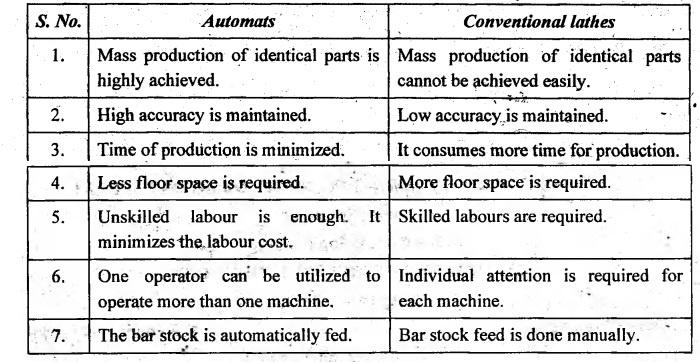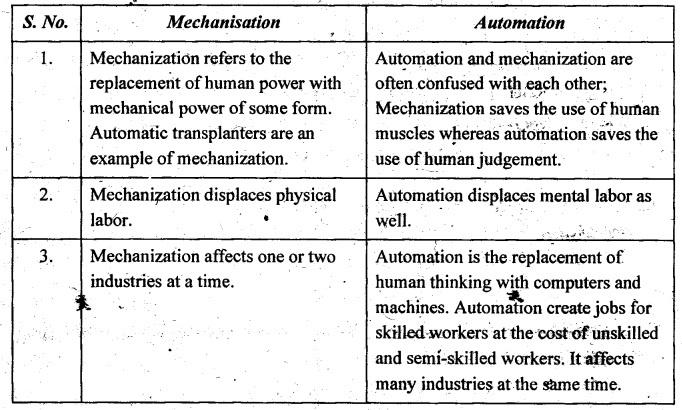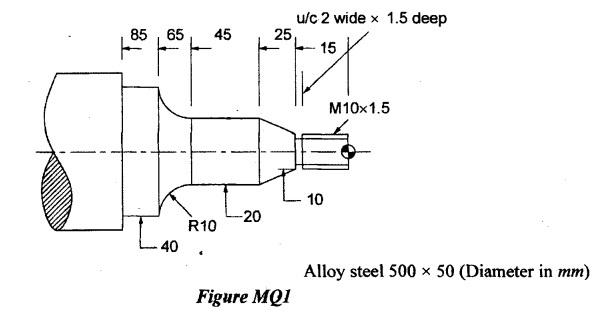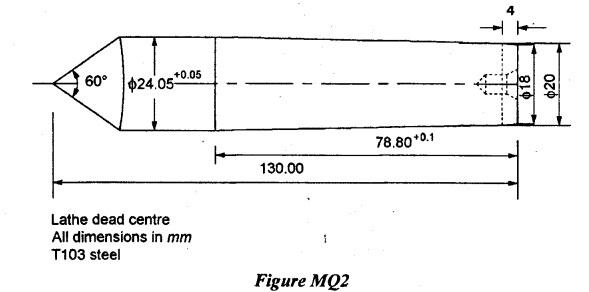Manufacturing Technology: Solved Model Question Papers
B.E./B.TECH. degree examination, model question paper-1
Solved Model Question Papers - Manufacturing Technology
B.E./B.TECH. degree examination, model question paper-1: Solved Model Question Papers - Manufacturing Technology
Solved Model Question Papers B.E./B.TECH. DEGREE EXAMINATION, MODEL QUESTION PAPER-1 Time: Three hours Fourth Semester Mechanical Engineering ME 3493 - MANUFACTURING TECHNOLOGY (Regulation 2021) Answer ALL questions Maximum: 100 marks Part A - (10 × 2 = 20 Marks) 1. What do you understand by cutting tool signature? The various angles of tools are mentioned in a numerical number in a particular order. This order is known as tool signature. Example: A tool having 8, 8, 5, 5, 6, 6, and 1 as signature in ASA system will have the following angles. Back rake angle = 8° Side rake angle = 8° End relief angle = 5° Side relief angle = 5° End cutting edge angle = 6° Side cutting edge = 6° Nose radius = 1 mm. 2. Classify the types of cutting fluids. There are basically two main types of cutting fluids. (a) Water based cutting fluid (b) Straight or heat oil based cutting fluid. 3. State the advantages of automats over conventional lathes. 4. Write short notes on tool layout. These planning of operation sequence and preparation of turret or capstan are termed as tool layout. The accuracy and cost of the product are largely dependent on an efficient tool layout. The tool layout mainly consists of three stages. 1. Planning and scheduling stage: preparation of operation sheet with the order of operation. 2. Detailed sketching of various stages of machining operations in a sequence of operations. 3. Sketching the plan showing the various tools fitted into the hexagonal turret faces and on the cross slides in a proper sequence. 5. Explain the principle of Quick return motion. To convert the rotary motion of a motor into reciprocating motion of the tool, the various types of drives are provided in the shaper because the metal is removed during forward stroke. But no metal is cut during return stroke. Due to this, the time taken for return stroke should be reduced by making the return stroke faster than the cutting stroke. It is achieved by some quick return mechanisms. 6. Why reaming operation is performed? Reaming operation is performed to finish drilled holes accurately to size and with a good surface finish. Reaming is a finishing operation of high-precision holes performed with a multi-edge tool. The cannot produce a hole, It simply follows the path of reamer an already drilled hole. It removes less amount of metal. 7. State the limitations of CNC machine tools. (i) CNC machines are more expensive than manually operated machines, although costs are slowly coming down. (ii) A CNC machine operator only needs basic training and skills which are enough to supervise several machines. Engineers are needed years of training to operate centre lathes, milling machines and other manually operated machines. It means many of the old skills are been lost. (iii) Less workers are required to operate CNC machines compared to manually operated machines. The investment for CNC machines can lead to unemployment. 8. Distinguish Mechanisation and Automation. 9. What is NC part programming? NC part programming is an advanced form of computer-assisted part programming in which an interactive graphics system equipped with NC programming software is used to facilitate the part programming task. 10. What are G-codes and M-codes? G-codes are preparatory function codes which prepare the machine or tool for different modes of movement such as positioning, contouring, thread cutting etc. Eg. G00-Point to point positioning G01 - Linear interpolation. M-codes are miscellaneous function codes which denote the auxiliary or switching information coolant on/off, spindle speed etc. Eg. M00 – Pregame stop and M01 - Optional stop. Part B (5 x 13 = 65 Marks) 11. (a) Detail the nomenclature of single point cutting tool with illustrative sketches. Refer chapter 1.4.2 on Page 1.6. Or (b) (i) Classify the types of chip formation and elaborate its types. Refer chapter 1.12 on Page 1.19. (ii) Write short notes on the following: (1) Rake angles Refer chapter 1.5 on Page 1.9. (2) Cutting fluids. Refer chapter 1.35 on Page 1.90. 12. (a) Describe the types of machining operations that can be performed on a lathe, with a neat sketch. Refer chapter 2.9 on Page 2.24. Or (b) Describe the method of operation of the Swiss-type automatic lathe, with application and tools used. Refer chapter 2.22.2 on Page 2.107. 13. (a) (i) Sketch a twist drill and label. Refer chapter 3.4.5 on Page 3.61. (ii) With a help of diagram explain crank and slotted link mechanism. Refer chapter 3.1.5.2 on Page 3.7. Or (b) With the help of a block diagram describe a Vertical spindle rotary-table grinder. Refer chapter 3.9.4.4 on Page 3.176. 14. (a) (i) List the advantages of CNC systems over conventional systems. Refer chapter 4.13 on Page 4.71. (ii) Describe the spindle drives used in CNC machine tools. Refer chapter 4.3.8 on Page 4.28. Or (b) With a neat sketch, explain the constructional features of turning centres. Refer chapter 4.15.1 on Page 4.74. 15. (a) Write the necessary part program for the part shown in Figure MQ1: Same as AU Problem 5.7 on Page 5.78. Or (b) Explain the following in CNC machining: (1) Linear interpolation Refer chapter 5.9.8.2 on Page 5.30. (2) Circular interpolation Refer chapter 5.9.8.3 on Page 5.30. (3) Cubic interpolation. Refer chapter 5.9.8.4 on Page 5.31. Part C - (1 × 15 = 15 Marks) 16. (a) Write a note on heat generation in metal cutting. What is the importance of analysing the thermal aspects of machining? Refer chapter 1.27 on Page 1.63. Or (b) The component shown in Figure MQ2 is to be manufactured at the rate of 500 components per month. Specify machine tools and cutting tools to be used to machine the component from a bar stock of dimension 140 mm length and 26 mm diameter. Justify your answer. Same as AU Problem 2.7 on Page 2.97.



Manufacturing Technology: Solved Model Question Papers : Tag: : Solved Model Question Papers - Manufacturing Technology - B.E./B.TECH. degree examination, model question paper-1